Khartoum
| Khartoum الخرطوم | ||
|---|---|---|
| City | ||
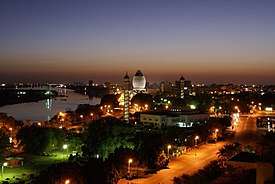 Khartoum at night | ||
| ||
| Nickname(s): Triangular Capital | ||
| Coordinates: 15°30′2″N 32°33′36″E / 15.50056°N 32.56000°ECoordinates: 15°30′2″N 32°33′36″E / 15.50056°N 32.56000°E[1] | ||
| Country | Sudan | |
| State | Khartoum | |
| Government | ||
| • Governor | Abdel Rahim Mohammed Hussein | |
| Area | ||
| • City | 971.2 km2 (375.0 sq mi) | |
| Elevation[1] | 381 m (1,250 ft) | |
| Population (2013 (urban as of 2014)) | ||
| • City | 639,598[2] | |
| • Urban | 5,490,000[3] | |
| • Metro | 5,274,321[2] | |
| Demonym(s) | Khartoumese, Khartoumian (the latter more properly designates a Mesolithic archaeological stratum) | |
| Time zone | UTC+2 (CAT) | |
Khartoum (/kɑːrˈtuːm/; kar-TOOM)[4][5] is the capital and largest city of Sudan. It is located at the confluence of the White Nile, flowing north from Lake Victoria, and the Blue Nile, flowing west from Ethiopia. The location where the two Niles meet is known as "al-Mogran" (المقرن; English: "The Confluence"). The main Nile continues to flow north towards Egypt and the Mediterranean Sea.
Divided by the two Rivers Nile, Khartoum is a tripartite metropolis with an estimated overall population of over five million people, consisting of Khartoum proper, and linked by bridges to Khartoum North (الخرطوم بحري; al-Kharṭūm Baḥrī) and Omdurman (أم درمان; Umm Durmān) to the west. The city is the capital of the state of Khartoum.
History
Etymology
The origin of the word, "Khartoum", is uncertain. One theory argues that khartoum is derived from Arabic khurṭūm (خرطوم trunk or hose), probably referring to the narrow strip of land extending between the Blue and White Niles.[6] Dinka scholars argue that the name derives from the Dinka words pronounce as "Khar-tuom" by Dinka bor and "Khier-tuom" by other Dinka ethnic groups. These translate to a "place where rivers meet". This is supported by historical accounts which place the Dinka homeland in central Sudan as late as the 13th-15th centuries A.D.[7] Captain J.A. Grant, who reached Khartoum in 1863 with Captain Speke's expedition, thought the name was most probably from the Arabic qurtum (قرطم safflower, i.e., Carthamus tinctorius), which was cultivated extensively in Egypt for its oil to be used as fuel.[8] Some scholars speculate that the word derives from the Nubian word, Agartum ("the abode of Atum"), the Nubian and Egyptian god of creation. Other Beja scholars suggest "Khartoum" is derived from the Beja word, Hartoom ("meeting").[9][10] Additionally, the dream-interpreting magicians in Genesis 41:8 are referred to as חַרְטֻמֵּ֥י מצרים("Khartoumei Mitzrayim" - Magicians of Egypt). There is some speculation that they learned their craft at an academy in the south of Egypt from which the city takes its name.
Founding (1821–1899)

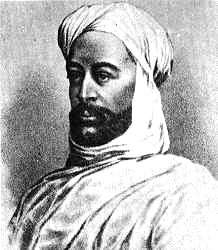
In 1821, Khartoum was established 24 kilometres (15 mi) north of the ancient city of Soba, by Ibrahim Pasha, the son of Egypt's ruler, Muhammad Ali Pasha, who had just incorporated Sudan into his realm. Originally, Khartoum served as an outpost for the Egyptian Army, but the settlement quickly grew into a regional centre of trade. It also became a focal point for the slave trade. Later, it became the administrative center of Sudan and official capital.
On 13 March 1884, troops loyal to the Mahdi Muhammad Ahmad started a siege of Khartoum, against defenders led by British General Charles George Gordon. The siege ended in a massacre of the Anglo-Egyptian garrison when on 26 January 1885 the heavily-damaged city fell to the Mahdists.[11]
On 2 September 1898, Omdurman was the scene of the bloody Battle of Omdurman, during which British forces under Herbert Kitchener defeated the Mahdist forces defending the city.
Modern history (20th–21st centuries)

In 1973, the city was the site of an anomalous hostage crisis in which members of Black September held 10 hostages at the Saudi Arabian embassy, five of them diplomats. The US ambassador, the US deputy ambassador, and the Belgian chargé d'affaires were murdered. The remaining hostages were released. A 1973 United States Department of State document, declassified in 2006, concluded: "The Khartoum operation was planned and carried out with the full knowledge and personal approval of Yasser Arafat."[12]
In 1977, the first oil pipeline between Khartoum and the Port of Sudan was completed.
Throughout the 1970s and 1980s, Khartoum was the destination for hundreds of thousands refugees fleeing conflicts in neighboring nations such as Chad, Eritrea, Ethiopia, and Uganda. Many Eritrean and Ethiopian refugees assimilated into society, while others settled in large slums at the outskirts of the city. Since the mid-1980s, large numbers of refugees from South Sudan and Darfur fleeing the violence of the Second Sudanese Civil War and Darfur conflict have settled around Khartoum.
In 1991, Osama bin Laden purchased a house in the affluent al-Riyadh neighborhood of the city and another in Soba. He lived there until 1996, when he was banished from the country. Following the 1998 U.S. embassy bombings, the United States accused bin Laden's al-Qaeda group and, on 20 August, launched cruise missile attacks on the al-Shifa pharmaceutical factory in northern Khartoum. The destruction of the factory produced diplomatic tension between the U.S. and Sudan. The factory ruins are now a tourist attraction.
The sudden death of SPLA head and vice-president of Sudan, John Garang, at the end of July 2005, was followed by three days of violent riots in the capital. The riots finally died down after Southern Sudanese politicians and tribal leaders sent strong messages to the rioters. The situation could have been much more dire; even so, the death toll was at least 24, as youths from southern Sudan attacked northern Sudanese and clashed with security forces.[13]
The Organisation of African Unity summit of 18–22 July 1978 was held in Khartoum, during which Sudan was awarded the OAU presidency. The African Union summit of 16–24 January 2006 was held in Khartoum.
The Arab League summit of 28–29 March 2006 was held in Khartoum, during which the Arab League awarded Sudan the Arab League presidency.
On 10 May 2008, the Darfur rebel group, Justice and Equality Movement, moved into the city, where they engaged in heavy fighting with Sudanese government forces. Their soldiers included minors, and their goal was to topple Omar al-Bashir's government, though the Sudanese government succeeded in beating back the assault.[14][15][16]
On 23 October 2012, an explosion at the Yarmouk munitions factory killed two people and injured another person. The Sudanese government has claimed that the explosion was the result of an Israeli airstrike.[17]
Geography
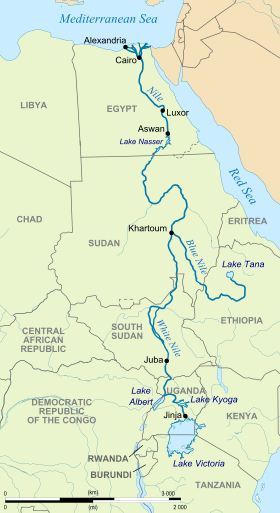
Location
Khartoum is located in the middle of the populated areas in Sudan, at almost the northeast center of the country between 15 and 16 degrees latitude north, and between 31 and 32 degrees longitude east.[18] Khartoum marks the convergence of the White Nile and the Blue Nile, where they join to form the bottom of the leaning-S shape of the main Nile (see map, upper right) as it zigzags through northern Sudan into Egypt at Lake Nasser.
Khartoum is relatively flat, at elevation 385 m (1,263 ft),[18] as the Nile flows northeast past Omdurman to Shendi, at elevation 364 m (1,194 ft)[19] about 101 miles (163 km) away.
Climate
Under Köppen's climate classification system, Khartoum features a hot arid climate, with only the summer months seeing noticeable precipitation.[21] The city averages a little over 155 millimetres (6.1 in) of precipitation per year. Based on annual mean temperatures, the city is one of the hottest major cities in the world. Temperatures routinely exceed 40 °C (104 °F) in mid-summer.
Its average annual high temperature is 37.1 °C (99 °F), with six months of the year seeing an average monthly high temperature of at least 38 °C (100 °F). Furthermore, throughout the year, none of its monthly average high temperatures falls below 30 °C (86 °F). During the months of January and February, while daytime temperatures are generally very warm, nights are relatively cool, with average low temperatures just above 15 °C (59 °F).
| Climate data for Khartoum (1971–2000) | |||||||||||||
|---|---|---|---|---|---|---|---|---|---|---|---|---|---|
| Month | Jan | Feb | Mar | Apr | May | Jun | Jul | Aug | Sep | Oct | Nov | Dec | Year |
| Record high °C (°F) | 39.7 (103.5) |
42.5 (108.5) |
45.2 (113.4) |
46.2 (115.2) |
46.8 (116.2) |
46.3 (115.3) |
44.5 (112.1) |
43.5 (110.3) |
44.0 (111.2) |
43.0 (109.4) |
41.0 (105.8) |
39.0 (102.2) |
46.8 (116.2) |
| Average high °C (°F) | 30.7 (87.3) |
32.6 (90.7) |
36.5 (97.7) |
40.4 (104.7) |
41.9 (107.4) |
41.3 (106.3) |
38.5 (101.3) |
37.6 (99.7) |
38.7 (101.7) |
39.3 (102.7) |
35.2 (95.4) |
31.7 (89.1) |
37.0 (98.6) |
| Daily mean °C (°F) | 23.2 (73.8) |
25.0 (77) |
28.7 (83.7) |
31.9 (89.4) |
34.5 (94.1) |
34.3 (93.7) |
32.1 (89.8) |
31.5 (88.7) |
32.5 (90.5) |
32.4 (90.3) |
28.1 (82.6) |
24.5 (76.1) |
29.9 (85.8) |
| Average low °C (°F) | 15.6 (60.1) |
16.8 (62.2) |
20.3 (68.5) |
24.1 (75.4) |
27.3 (81.1) |
27.6 (81.7) |
26.2 (79.2) |
25.6 (78.1) |
26.3 (79.3) |
25.9 (78.6) |
21.0 (69.8) |
17.0 (62.6) |
22.8 (73) |
| Record low °C (°F) | 8.0 (46.4) |
8.6 (47.5) |
12.6 (54.7) |
12.7 (54.9) |
18.5 (65.3) |
20.2 (68.4) |
17.8 (64) |
18.0 (64.4) |
17.7 (63.9) |
17.5 (63.5) |
11.0 (51.8) |
6.2 (43.2) |
6.2 (43.2) |
| Average precipitation mm (inches) | 0.0 (0) |
0.0 (0) |
0.1 (0.004) |
0.0 (0) |
3.9 (0.154) |
4.2 (0.165) |
29.6 (1.165) |
48.3 (1.902) |
26.7 (1.051) |
7.8 (0.307) |
0.7 (0.028) |
0.0 (0) |
121.3 (4.776) |
| Average precipitation days (≥ 0.1 mm) | 0.0 | 0.0 | 0.1 | 0.0 | 0.9 | 0.9 | 4.0 | 4.2 | 3.4 | 1.2 | 0.0 | 0.0 | 14.7 |
| Average relative humidity (%) | 27 | 22 | 17 | 16 | 19 | 28 | 43 | 49 | 40 | 28 | 27 | 30 | 29 |
| Mean monthly sunshine hours | 316.2 | 296.6 | 316.2 | 318.0 | 310.0 | 279.0 | 269.7 | 272.8 | 273.0 | 306.9 | 303.0 | 319.3 | 3,580.7 |
| Mean daily sunshine hours | 10.2 | 10.5 | 10.2 | 10.6 | 10.0 | 9.3 | 8.7 | 8.8 | 8.1 | 9.9 | 10.1 | 10.3 | 9.8 |
| Source #1: World Meteorological Organisation,[22] NOAA (extremes and humidity 1961–1990)[23] | |||||||||||||
| Source #2: Deutscher Wetterdienst (sun, 1961–1990)[24] | |||||||||||||
Demographics
| Year | Population | |
|---|---|---|
| City | Metropolitan area | |
| 1907[25] | 69,349 | n.a. |
| 1956 | 93,100 | 245,800 |
| 1973 | 333,906 | 748,300 |
| 1983 | 476,218 | 1,340,646 |
| 1993 | 947,483 | 2,919,773 |
| 2008 Census Preliminary | 3,639,598 | 5,274,321 |
Economy
_003.jpg)
After the signing of the historic Comprehensive Peace Agreement between the government of Sudan and the Sudan People's Liberation Movement (SPLA), the Government of Sudan began a massive development project.[26][27] In 2007, the biggest projects in Khartoum were the Al-Mogran Development Project, two five-star hotels, a new airport, Mac Nimir Bridge (finished in October 2007) and the Tuti Bridge that links Khartoum to Tuti Island.
In the 21st century, Khartoum developed based on Sudan's oil wealth (although the independence of South Sudan in 2011 affected the economy of Sudan negatively[28]). The center of the city has tree-lined streets. Khartoum has the highest concentration of economic activity in the country. This has changed as major economic developments take place in other parts of the country, like oil exploration in the South, the Giad Industrial Complex in Al Jazirah state and White Nile Sugar Project in Central Sudan, and the Merowe Dam in the North.
Among the city's industries are printing, glass manufacturing, food processing, and textiles. Petroleum products are now produced in the far north of Khartoum state, providing fuel and jobs for the city. One of Sudan's largest refineries is located in northern Khartoum.[28]
Retailing
The Souq Al Arabi is Khartoum's largest open air market. The "souq" is spread over several blocks in the center of Khartoum proper just south of the Great Mosque (Mesjid al-Kabir) and the minibus station. It is divided into separate sections, including one focused entirely on gold.[29]
Al Qasr Street and Al Jamhoriyah Street are considered the most famous high streets in Khartoum State.
Afra Mall is located in the southern suburb Arkeweet. The Afra Mall has a supermarket, retail outlets, coffee shops, a bowling alley, movie theaters, and a children's playground.
In 2011, Sudan opened the Hotel Section and part of the food court of the new, Corinthia Hotel Tower. The Mall/Shopping section is still under construction.
Education
Khartoum is the main location for most of Sudan's top educational bodies. In Khartoum, the capital of Sudan, there are four main levels of education. First: kindergarten and day-care. It begins in the age of 3-4, consists of 1-2 grades, (depending on the parents). Second: elementary school. the first grade pupils enter at the age of 6-7 .and It consists of 8 grades, each year there is more academic efforts and main subjects added plus more school methods improvements. By the 8th grade a student is 13–14 years old ready to take the certificate exams and entering high school. Third: upper second school and high school. At this level the school methods add some main academic subjects such as chemistry, biology, physics, geography, etc... there are three grades in this level. The students ages are about 14-15 to 17-18. Higher Education: there are many universities in Sudan such as the university of Khartoum. Some foreigners attend universities there, as the reputation of the universities are very good and the living expenses are low compared to other countries. The education system in Sudan went through many changes in the late 1980s and early 1990s.[30][31][32]
High schools
- Khartoum Old High Secondary School for Boys
- Khartoum Old High Secondary School for Girls
- The British Educational Schools (BES)[33]
- Khartoum American School, KAS, established in 1957.
- Khartoum International Community School, KICS, established in 2004.
- Unity High School.[34]
- Suliman Hussein Academy
- Comboni and St. Francis, Khartoum new high secondary school for boys
- Khartoum International preparatory school (KIPS)|Khartoum International preparatory school, established in 1928.
- Qabbas Private International Schools
- Riad English School, established 1987
- Nile Valley School, founded 2012 [35]
- Mohamed Hussein High Secondary School for Boys in Omdurman
Universities and Higher institutes in Khartoum
| The great higher institutes in Khartoum | |||||||||||||
|---|---|---|---|---|---|---|---|---|---|---|---|---|---|
| Educational institution | Type | The website | |||||||||||
| University of Khartoum Founded as Gordon Memorial College in 1902, it was later renamed to share the name of the city in the 1930s. | Public university | http://www.uofk.edu | |||||||||||
| Academy of Engineering Sciences founded as Academy of Electrical Engineering in 2002, | private university | http://www.aes.edu.sd | |||||||||||
| Al-Neelain University, | Public university | http://www.neelain.edu.sd | |||||||||||
| Al Zaiem Alazhari University, | Public university | http://www.aau.edu.sd | |||||||||||
| Bahri University, formally Juba University before the separation and Juba University returned to the South. | Public university | ||||||||||||
| Omdurman Islamic University, | Public university | ||||||||||||
| International University of Africa, | Public university | http://www.iua.edu.sd | |||||||||||
| Nile Valley University, | Public university | ||||||||||||
| Open University of Sudan, | Public university | http://www.ous.edu.sd | |||||||||||
| Public Health Institute, a post-graduate institution operated by the Ministry of Health | Public university | http://www.phi.edu.sd | |||||||||||
| Sudan University of Science and Technology, one of the leading engineering and technology schools in Sudan, founded in 1932 as Khartoum Technical Institute and has been given its present name in 1991. | Public university | http://www.sustech.edu | |||||||||||
| AlMughtaribeen University, | Private universities | http://www.mu.edu.sd | |||||||||||
| Bayan College for Science & Technology, | Private universities | https://web.archive.org/web/20110920215435/http://www.bayantech.edu/ | |||||||||||
| Canadian Sudanese College, | Private universities | http://www.ccs.edu.sd | |||||||||||
| Comboni College for Science and Technology | Private universities | http://www.combonikhartoum.com | |||||||||||
| Future University of Sudan, the first specialized university for ICT inter-related studies in Sudan, founded by Dr. Abubaker Mustafa. | Private universities | http://www.futureu.edu.sd | |||||||||||
| National College for Medical & Technical Studies, | Private universities | https://web.archive.org/web/20131203001023/http://www.nc.edu.sd/ | |||||||||||
| National Ribat University, | Private universities | http://www.ribat.edu.sd | |||||||||||
| University of Medical Sciences and Technology, better known as UMST, it was founded in 1996 by Prof. Mamoun Humaida as Academy of Medical Science & Technology. | Private universities | ||||||||||||
|Omdurman Al-ahlia University, || Private university Found it in 1985||
Transportation
Air
Khartoum is home to the largest airport in Sudan, Khartoum International Airport. It is the main hub for Sudan Airways, Sudan's main carrier. The airport was built at the southern edge of the city; but with Khartoum's rapid growth and consequent urban sprawl, the airport is currently located in the heart of the city. A new international airport is currently being built about 40 km (25 mi) south of the city center. There have been delays to start construction because lack of funding of the project but it is expected that the airport will be completed sometime in 2018. It will replace the current airport in Khartoum as Sudan's main airport.
Bridges
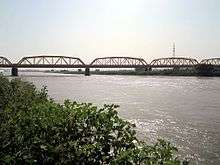
The following bridges cross the Blue Nile and connect Khartoum to Khartoum North:
Rail
Khartoum has rail lines from Wadi Halfa, Port Sudan on the Red Sea, and El Obeid. All are operated by Sudan Railways. Some lines also extended to some parts of south Sudan
| Some roads and streets of Khartoum | |||||||||||||
|---|---|---|---|---|---|---|---|---|---|---|---|---|---|
| |||||||||||||
Architecture


Architecture of Khartoum cannot be identified by one style or even two styles; it is as diverse as its culture, where 597 different cultural groups meet. In this article are 10 buildings of Khartoum to showcase this diversity in buildings’ shapes, materials, treatments. Sudan was home to numerous ancient civilizations, such as the Kingdom of Kush, Kerma, Nobatia, Alodia, Makuria, Meroë and others, most of which flourished along the Nile. During the pre-dynastic period Nubia and Nagadan Upper Egypt were identical, simultaneously evolved systems of Pharaonic kingship by 3300 BC.
In response to the worldwide deterioration of the environment and the increase in pollution levels, there has been a strong movement towards sustainable architecture across the globe. This movement has received attention and concern from governments as well as private sectors. In the past decades, Sudan has seen a huge surge in infrastructure and technology, which has led to many new and innovative building concepts, ideas and construction techniques. There is now a constant flow of new projects arising, thus leading to a new, transformed, modernised form of architecture. [38]
- Squares and public gardens
Masjids and Places of worship
 The Great Masjid
The Great Masjid Masjid Shahid
Masjid Shahid Faruq Mosque,Khartum
Faruq Mosque,Khartum- Siadah Sanhory mosque in Manshiya
- Shahid mosque Algomah prayers in Ramadan
Culture

Museums
The largest museum in all of Sudan is the National Museum of Sudan.[40] Founded in 1971, it contains works from different epochs of Sudanese history. Among the exhibits are two Egyptian temples of Buhen and Semna,[41] originally built by Queen Hatshepsut and Pharaoh Tuthmosis III, respectively, but relocated to Khartoum upon the flooding of Lake Nasser.
The Republican Palace Museum,[42] opened in 2000, is located in the former Anglican All Saints' cathedral[43] on Sharia al-Jama'a, next to the historical Presidential Palace.
The Ethnographic Museum[44] is located on Sharia al-Jama'a, close to the Mac Nimir Bridge.
Botanical gardens
Khartoum is home to a small botanical garden, in the Mogran district of the city.[45]
Clubs
Khartoum is home to several clubs such as the Blue Nile Sailing Club,[46] the German Club, the Greek Hotel,[47] the Coptic Club, the Syrian Club and the International Club.[48] There are also two football clubs situated in Khartoum – Al Khartoum SC[49] and Al Ahli Khartoum.[50]
Twin cities
See also
- Al-Mogran Development Project
- Khartoum, a 1966 film starring Charlton Heston and Laurence Olivier
- Al Amarat (Khartoum)
- St. Matthew's Cathedral, Khartoum
References
- 1 2 "Where is Khartoum, The Sudan?". worldatlas.com. 2018. Retrieved 2018-01-28.
- 1 2 "Sudan Facts on Largest Cities, Populations, Symbols - Worldatlas.com". www.worldatlas.com. 7 April 2017. Retrieved 9 February 2018.
- ↑ Demographia World Urban Areas (PDF) (14th ed.). Demographia. April 2018. p. 66. Retrieved 25 May 2018.
- ↑ "Khartoum". Dictionary.reference.com.
- ↑ "Khartoum". TheFreeDictionary.com.
- ↑ Beswick, Stephanie (2013). Sudan's Blood Memory: The Legacy of War, Ethnicity, and Slavery in Early South Sudan. p. 39.
- ↑ Room, Adrian (2006). Placenames of the World (2nd ed.). McFarland. p. 194. ISBN 0-7864-2248-3.
- ↑ Walkley, C. E. J. (1935). "THE STORY OF KHARTOUM" [2017-01-01]. Sudan Notes and Records. University of Khartoum. 18 (2): 221–241. doi:10.2307/41710712. JSTOR 41710712.
- ↑ "Beja scholars and the creativity of powerlessness". Passages. University of Michigan Library.
- ↑ Hasan Shukri (August 1966). "Khartoum and Tuti 'Shreen Munz Qarnan". Khartoum. 1 (11): 23.
- ↑ Hammond, Peter (2005). Slavery, Terrorism & Islam. Cape Town, South Africa: Christian Liberty Books.
- ↑ "The Seizure of the Saudi Arabian Embassy in Khartoum" (PDF). U.S. Department of State. Archived from the original (PDF) on 2006-12-16. Retrieved 2014-01-28.
- ↑ "World | Africa | Riots after Sudan VP Garang dies". BBC News. 1 August 2005. Retrieved 27 June 2010.
- ↑ "Curfew in capital as Sudanese army clash near Khartoum with Darfur rebels". Sudan Tribune. 10 May 2008.
- ↑ "Sudanese rebels 'reach Khartoum'". BBC News. 10 May 2008.
- ↑ "PHOTOS: Sudan capital after today's attack from Darfur JEM". Sudan Tribune. 10 May 2008.
- ↑ "Khartoum fire blamed on Israeli bombing". Al Jazeera. 25 October 2012. Retrieved 25 October 2012.
- 1 2 "Khartoum Elevation (385m)". distancesto.com. 2018. Retrieved 2018-01-28.
- ↑ "Shendi Elevation (364m)". distancesto.com. 2018. Retrieved 2018-01-28.
- ↑
- ↑ Peel, M. C.; B. L. Finlayson; T. A. McMahon (2007). "Updated world map of the Köppen-Geiger climate classification" (PDF). Hydrology and Earth System Sciences. 11: 1633–1644. Bibcode:2007HESS...11.1633P. doi:10.5194/hess-11-1633-2007.
- ↑ "World Weather Information Service – Khartoum". World Meteorological Organization. Retrieved 6 May 2010.
- ↑ "Khartoum Climate Normals 1961–1990". National Oceanic and Atmospheric Administration. Retrieved January 16, 2014.
- ↑ "Klimatafel von Khartoum / Sudan" (PDF). Baseline climate means (1961-1990) from stations all over the world (in German). Deutscher Wetterdienst. Retrieved 22 October 2016.
- ↑ "Encyclopædia Britannica von 1911: Band 15, Seite 773". Encyclopedia.jrank.org. Retrieved 27 June 2010.
- ↑ "Sudan and UNDP launch Millennium Goals project". Sudan Tribune. 5 September 2005. Retrieved 28 June 2008.
- ↑ Winter, Joseph (24 April 2007). "Khartoum booms as Darfur burns". BBC. Retrieved 28 June 2008.
- 1 2 "Country Analysis Brief: Sudan and South Sudan" (PDF). US Energy Information Administration. 2014-09-03. p. 13-14 Oil refineries. Retrieved 2010-07-14.
- ↑ "Sudan Shopping and Districts (Sudan, SD, North-East Africa)". World Guides. TravelSmart Ltd. 2016-06-07. Retrieved 2017-07-14.
- ↑ "وزارة تعليم عالي والبحث العلمي". حكومة سودان. Retrieved 25 May 2018.
- ↑ "وزارة التربية والتعليم". حكومة سودان. Retrieved 25 May 2018.
- ↑ null (24 January 2012). The Status of the Education Sector in Sudan. The World Bank. pp. 159–189. doi:10.1596/9780821388570_ch07 – via elibrary.worldbank.org (Atypon).
- ↑ "britisheducationsudan.com". britisheducationsudan.com. Archived from the original on 17 May 2014. Retrieved 20 May 2014.
- ↑ "Archived copy". Archived from the original on 1 February 2009. Retrieved 2012-08-19.
- ↑ http:/about.me/msaif30, MSaif / Original design: NVS Sudan -. "Nile Valley School - NVS in Brief". www.nilevalleyschool.com. Retrieved 25 May 2018.
- ↑ "Sudanese higher education". Ministry of Higher Education & Scientific Research. Retrieved 15 September 2011.
- ↑ "Universities of Sudan Ahfad university for women". Consejo Superior de Investigaciones Científicas. Archived from the original on 19 March 2012. Retrieved 15 September 2011.
- ↑ "Archnet". archnet.org. Archived from the original on 7 October 2012.
- ↑ "Archived copy". Archived from the original on 7 May 2015. Retrieved 4 April 2016.
- ↑ Shumba, Ano (2015-10-28). "Sudan National Museum ; Bio". Music in Africa. Retrieved 2017-07-14.
- ↑ "The Rescue of Nubian Monuments and Sites". UNESCO. 2017. Retrieved 2017-07-14.
- ↑ "Palace Museum". Presidency of the Republic of Sudan. 2016. Retrieved 2017-07-14.
- ↑ "Designs for the Cathedral Church of All Saints, Khartoum..." RIBApix. 2017. Retrieved 2017-07-14.
- ↑ "Museums In Sudan". The Embassy of the Republic of Sudan. Retrieved 2017-07-13.
- ↑ Jibreel, T. J. O. (2010). "2 - Materials and Methods, Site of collection" (PDF). Two Ichneumonid Parasitoid Wasps Affecting Ficus sycamorus (L.) Fruits in Khartoum State (Thesis). Khartoum, Sudan: University of Khartoum department of Zoology. pp. 20–22.
- ↑ Uloth, Tony (2011-01-18). "The Blue Nile Sailing Club". The Melik Society. Retrieved 2017-07-13.
- ↑ "Reuters.com". Africa.reuters.com. 9 February 2009. Archived from the original on 1 February 2013. Retrieved 20 May 2014.
- ↑ "Night clubs in Khartoum city". Fortune of Africa. Retrieved 2017-07-13.
- ↑ "Former Ghana coach Kwesi Appiah takes over at SC Khartoum". BBC Sport. 2014-12-17. Retrieved 2017-07-14.
- ↑ "Al Ahli Khartoum". FIFA (International Federation of Association Football). May 2017. Retrieved 2017-07-14.
- ↑ "İstanbul'un Kardeş Şehir, İşbirliği Protokolleri ve Mutabakat Zaptı/İyi Niyet Mektupları" [Istanbul's Sister Cities, Cooperation Protocols and Memorandum of Understanding/Goodwill Letters] (in Turkish). İstanbul Büyükşehir Belediyesi. Retrieved 2015-06-01.
- ↑ "Sister Cities of Istanbul". Istanbul. 2016. Retrieved 21 October 2016.
- ↑ "Ethiopia's Capital Addis Ababa and Khartoum sign twin cities agreement". Nazret. 26 September 2010. Retrieved 21 October 2016.
- ↑ "Kardeş Kentleri Listesi ve 5 Mayıs Avrupa Günü Kutlaması [via WaybackMachine.com]" (in Turkish). Ankara Büyükşehir Belediyesi – Tüm Hakları Saklıdır. Archived from the original on 14 January 2009. Retrieved 21 July 2013.
- ↑ "Brasilia Global Partners". Internacional.df.gov.br. Archived from the original on February 28, 2014. Retrieved 2017-07-13.
- ↑ "Brotherhood & Friendship Agreements Signed Between Cairo & Arab Cities". Ministry of State for Administrative Development, Cairo Governorate. 2016. Retrieved 21 October 2016.
Twinning document; Khartoum; Sudan; 14/2/1979
- ↑ "Sister Cities". Wuhan University. 2016. Retrieved 21 October 2016.
Bibliography
- See also: Bibliography of the history of Khartoum
External links
| Wikivoyage has a travel guide for Khartoum. |
![]()
- Kidnapped, tortured and thrown in jail: my 70 days in Sudan The Guardian, 2017

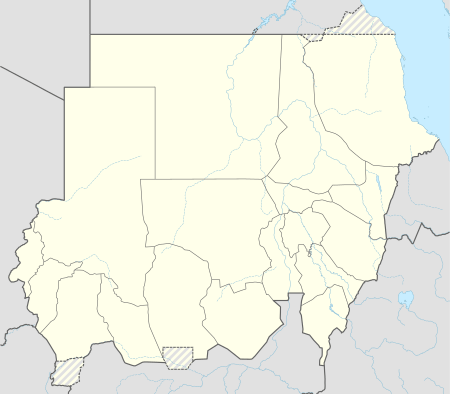



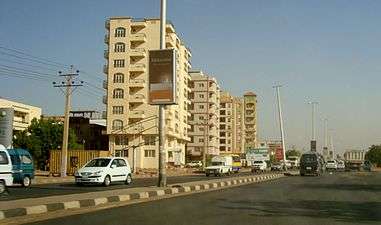
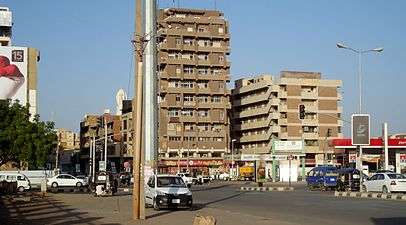

_001.jpg)